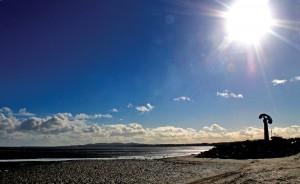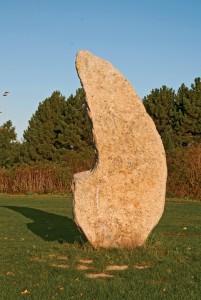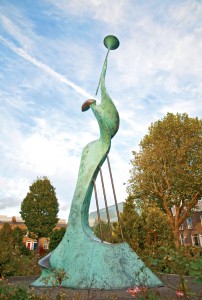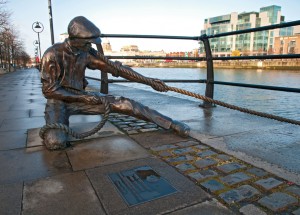
Have you ever stopped and watched the time set by the James Joyce solar pillar sculpture along Sandymount Strand? In bygone times, James Joyce himself walked the promenade making his observations that featured in Ulysses. He describes character Stephen Dedalus walking along the strand with his boots “crush, crackling, wrack” on the shells and as he strides along, the thought “open your eyes” intrudes into his mind.

It’s Stephen Dedalus who ponders, “Am I walking into eternity along Sandymount Strand”, and perhaps artist Cliodna Cussen had a similar thought when she created a sculpture in dedication to Joyce. The sculpture resembles a single large open quotation mark with an accompanying second smaller square of stone, yards away with the words inscribed An Gallán Gréine do James Joyce which translates as ‘A Solar Pillar for James Joyce’.
The sculpture is arranged so that every year at winter solstice on the 21st of December when the sun rises, a ray of light appears to align itself along the two elements of the sculpture. It was unveiled on a winter’s day in December 1983 by Lord Mayor Michael Keating on behalf of Dublin City Council.

An Cailín Ban stands high on north Sandymount Strand. This was created by Mexican artist Sebastian, who was born Enrique Carbajal González in 1947 and took on his pseudonym after Botticelli’s painting of St. Sebastian.
Based in Mexico City where he has numerous sculptures, his work also features all over the world in places such as Germany, Sweden, Norway, Canada, Columbia, Japan and here in Dublin. His sculptures are monumental in stature and mainly made of steel and concrete.
The sculpture on Sandymount Strand is the first work to be permanently placed here by a Mexican artist. It was erected in 2002 by Dublin City Council and presented by the then-Lord Mayor of Dublin, Dermot Lacey. It was donated by the Mexican government president Vincente Fox as a gesture of friendship between Mexico and Ireland. Originally called Geisha because of its shape, Sebastian himself renamed it to An Cailín Ban (The Fair Haired Girl).

Harmony in Pearse Park, off Pearse Street, is a sculptural figure blowing a trumpet and set in a backdrop of urban residential houses in this Georgian garden square, close to the city centre. This sculpture was erected to mark the opening of the newly refurbished park in 1998 by Dublin Corporation and was created by Sandra Bell. Before the refurbishment, there once was a bandstand where the sculpture now stands at 3.5 metres tall, the symbolic trumpet joining the past with the present as the figure aspiringly points towards the skies.
In the Docklands, The Linesman is a bronze life-size sculpture of a man pulling on a rope and it represents a time when merchant ships docked in the river Liffey. Created by Dony MacManus, this sculpture was a winning entry into a public art competition organised by Dublin Docklands Development Authority as part of a major rejuvenation of the area. It was unveiled in February 2000 and is located on City Quay between two notable bridges, the Talbot Memorial, which commemorates members of the Dublin Brigade who died in the War of Independence and the Sean O’Casey Bridge.
Public sculpture is alive and well in the capital city and if we keep our eyes open to our surroundings we may be surprised by the interesting artworks and the stories behind the sculptures, there for our observation.
Pictures from left: An Cailín Ban, by Sebastian, on Sandymount Strand. Photo by Ross Waldron.
A Sundial For James Joyce, by Cliodhna Cussen, on Sandymount Strand; Harmony, by Sandra Bell in Pearse Square, off Pearse Street; The Linesman by Dony MacManus. Photos by Leeza Kane.
By Leeza Kane

